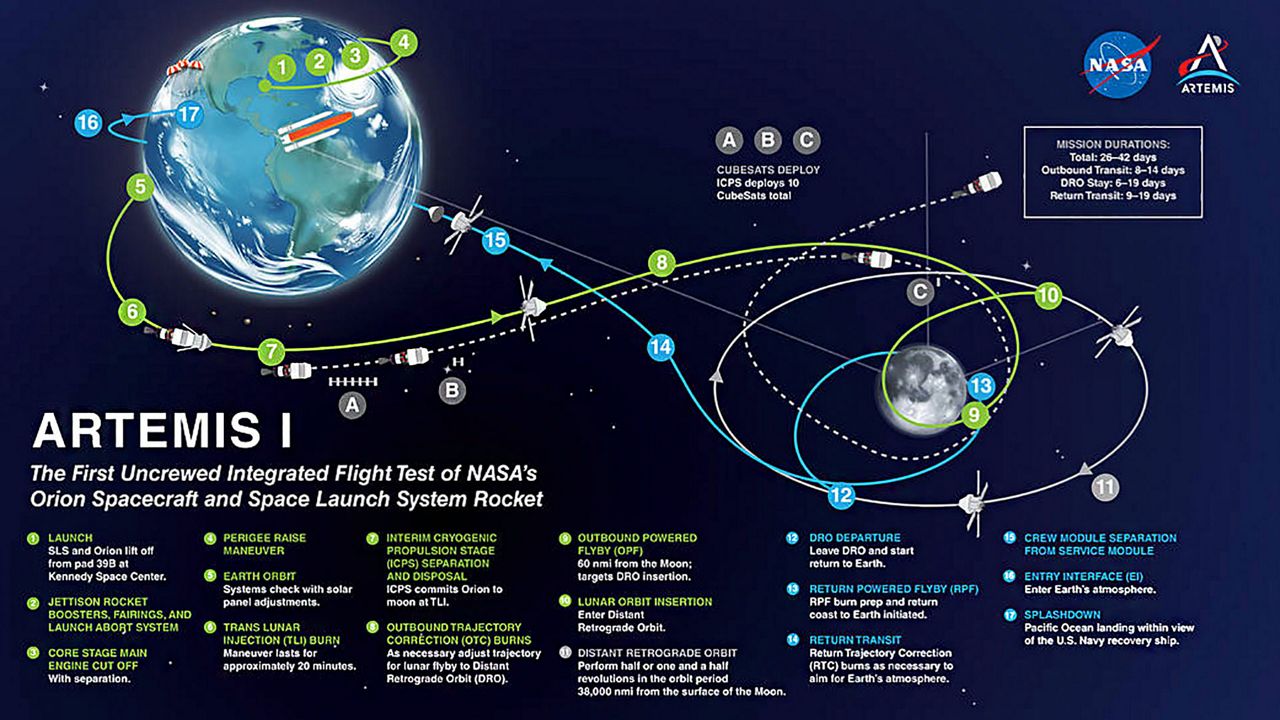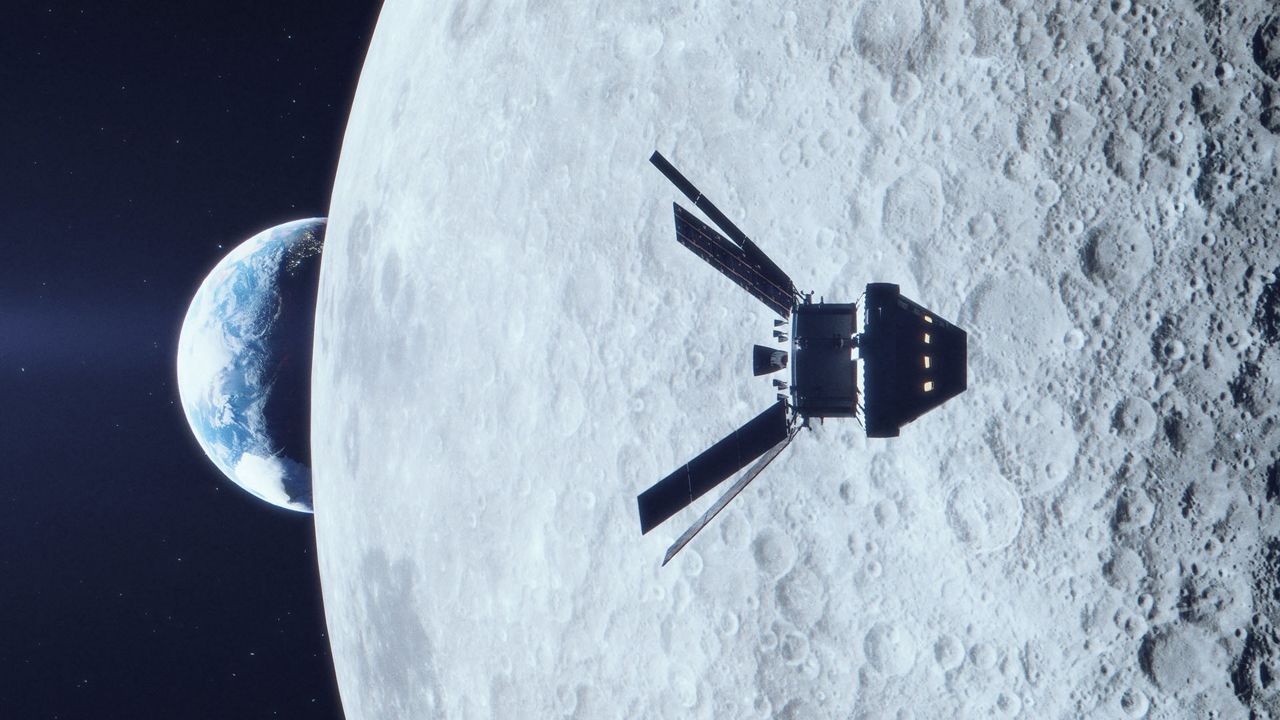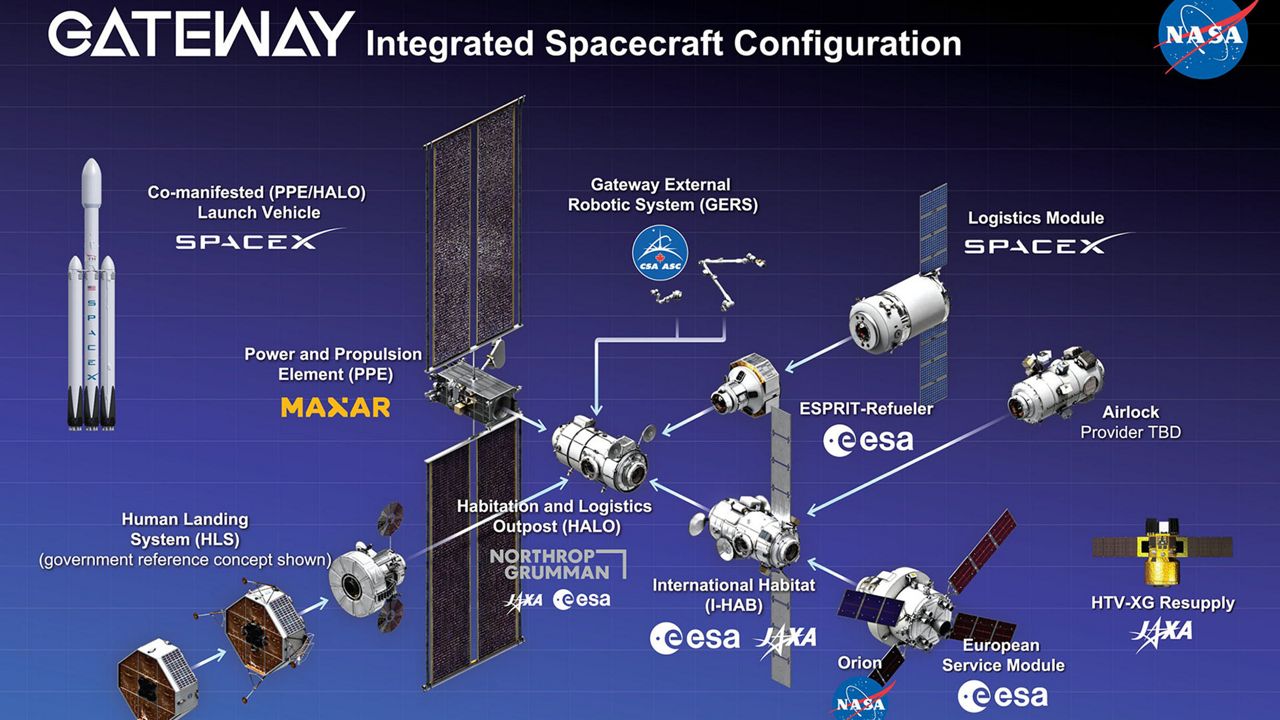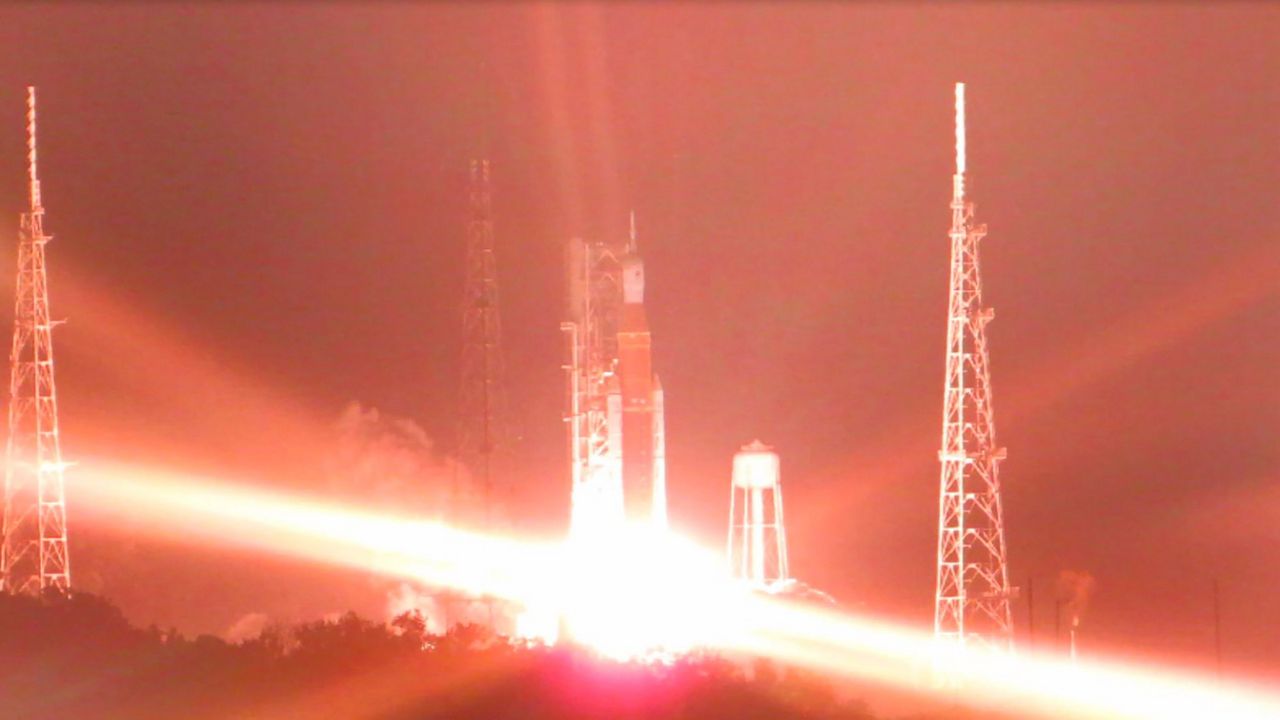KENNEDY SPACE CENTER — NASA successfully launched the uncrewed Artemis I to travel around the moon early Wednesday morning, after overcoming liquid hydrogen leaks, faulty switches and Mother Nature.
The Artemis I’s Space Launch System rocket, the most powerful one in the world currently, and the Orion spacecraft lifted off from Launch Pad 39B at the Kennedy Space Center at 1:47 a.m. EST.
Mission to the Moon
- The Artemis uncrewed mission took flight early Wednesday to orbit the moon
- The mission has suffered several setbacks due to tech and hurricane issues
- Previous Coverage
- 🔻SCROLL DOWN TO WATCH THE LAUNCH🔻
#BREAKING: @NASA successfully launched the uncrewed #Artemis I to the #moon early Wednesday morning, after overcoming liquid hydrogen leaks, faulty switches and Mother Nature.
— Anthony Leone (@AnthonyLeone) November 16, 2022
Check out this beautiful shot I got of #Artemis1.
Read my story here: https://t.co/gYURLM5TKq pic.twitter.com/XRlEGTKrvZ
The powerful RS-25 engines’ roar could not just be heard but felt for miles as they pierced into the sky and pushed the Orion into the blackness of space.
And the brightness of the engines was like looking into a small sun that somehow rose from Launch Pad 39B, in a near-blinding light that captivated all of those who waited for so long to witness this launch.
#BREAKING: #NASA’s #Artemis #moon rocket has launched! pic.twitter.com/OK7U8CEUX6
— Anthony Leone (@AnthonyLeone) November 16, 2022
Thousands of space enthusiasts from all walks of life who traveled near and far to the Space Coast witnessed the historic event of returning to Earth’s lunar sister.
NASA confirmed that the launch was a success, from the stage separation to the Orion’s solar arrays being deployed.
"The arrays are drawing power, and early data suggests good performance," NASA confirmed.
The mission is simple: Returning to the moon. But it took some time to get started.
Launch team optimistic about mission so far
Later in the morning, Artemis performed a propulsive maneuver that sent it toward its path to the moon.
Moonbound! #Artemis I has completed its trans-lunar injection, a propulsive maneuver that accelerates the @NASA_Orion spacecraft to more than 22,600 mph (36,370 kph) and propels it on its path to the Moon. pic.twitter.com/1YMedHnJwH
— NASA (@NASA) November 16, 2022
In a news conference after the launch, the team celebrated its success — saying, it’s not just about making it to the moon again. It’s about learning more.
They seem cautiously optimistic about the mission so far.
“We have a priority 1 mission in play right now," NASA Artemis Mission Manager Mike Sarafin said. "We had the rocket do its job. It delivered the spacecraft to the point of translunar injection, and I want to thank the SLS program for putting that priority mission in play — as well as Jodie Marshall of the Marshall Spaceflight Center. They did an amazing job of getting us to this point.”
Pre-launch technical difficulties
This fifth try to get Artemis off the launch pad had some wondering if there would be another scrub.
The Artemis I moon rocket was supposed to liftoff at 1:04 a.m. EST, Wednesday, but because of a faulty ethernet switch at the Eastern Range radar facility site, the mission slipped into the two-hour launch window, NASA officials said.
On Tuesday night, NASA stated that the Eastern Range gave the Artemis moon launch a “no go” because of a signal lost at the radar site.
Eastern Range officials told the launch test director that the launch is a “no go” until the radar site signal is fixed, stated NASA communications officer Derrol Nail. He said a bad ethernet switch caused the radar issue.
NASA’s Associate Administrator for Exploration System Development Jim Free said that engineers eventually replaced the switch and reverified the replacement.
Because of the issue, it has pushed the launch back.
"We are extending the countdown hold at T-10 minutes while the launch team estimates how much work needs to be done. This means we will slip into the two-hour launch window, and will share a revised launch time when it is confirmed," NASA stated.
.@NASA_SLS's upper stage is now in replenish for both liquid hydrogen and liquid oxygen. Working the testing to reverify the ethernet switch with the range. T-10 minute hold will be extended. #Artemis
— Jim Free (@JimFree) November 16, 2022
Then, another issue came up: Due to strong winds from Hurricane Nicole, the caulk (known as the room temperature vulcanizing/RTV) around the Orion and European Service Module has a sensor in it and the team determined that it was loose and could come off. If that were to happen, it would be likely to hit the launch vehicle stage adaptor.
But ultimately it was not an issue.
Earlier, NASA stated it stopped the flow of liquid hydrogen to the core stage because of an intermittent leak.
Nail said teams sent the red crew to the top of Launch Pad 39B. NASA’s Exploration Ground System tweeted that the red crew sent to “the pad to torque packing nuts at the base of the mobile launcher.”
We have stopped flow of liquid hydrogen to the core stage due to an intermittent leak on the replenish valve. Teams are discussing a plan to send out the 'red crew' to the pad to torque packing nuts at the base of the mobile launcher.
— NASA's Exploration Ground Systems (@NASAGroundSys) November 16, 2022
Nail said torquing the nuts would slow the intermittent leak at the mobile launcher.
"Engineers have paused flowing liquid hydrogen into the core stage because of a small leak on a hydrogen valve inside of the mobile launcher. A team of personnel called a red crew is being assembled to go to the pad to make sure all of the connections and valves remain tight. The valve is located within the base of the mobile launcher," NASA commented in a statement.
Nail said that due to the location of the work, it was considered a “hazardous” job.
Later, Nail said that the red crew completed their work at the pad and the launch team replenished the core stage liquid hydrogen.
Before the leak, both the liquid oxygen and liquid hydrogen tanks were both filled, but some of the liquid hydrogen boiled off because of the stop flow.
Astronaut and scientist Stanley Love explained to me why @NASA is so careful with the #Artemis launch and why being patient can lead to success. https://t.co/gYURLM5TKq pic.twitter.com/wnR3MGlxd1
— Anthony Leone (@AnthonyLeone) November 16, 2022
On Monday, the 45th Weather Squadron gave a 90% chance of good weather for the two-hour launch window.
Launch Countdown
Trying to launch
As the old saying around NASA goes, “space is hard” — and that has been readily apparent time and again with the uncrewed Artemis I mission.
Artemis I Launch Tries:
- Aug. 29, 2022: Liquid hydrogen leak and engine temperature issues
- Sept. 03, 2022: Liquid hydrogen leak
- Sept. 27, 2022: Hurricane Ian
- Nov. 14, 2022: Hurricane Nicole
It was first scheduled to launch back on Aug. 29, but a liquid hydrogen leak and engine temperature issues made engineers scrub the liftoff.
Once those issues were resolved, NASA tried again on Sept. 03, but a different liquid hydrogen leak was discovered. Once again the space agency was forced to postpone the launch.
NASA engineers replaced two seals on the fuel lines that go from the mobile launcher to the rocket. They performed a cryogenic demonstration test to see if the replacements worked.
During the Sept. 21 test, another liquid hydrogen leak was discovered, but NASA deemed the test a success because engineers were able to deal with the leak and fill up the liquid hydrogen side of the rocket.
But then came Mother Nature: NASA wanted a third try on Sept. 27, but Hurricane Ian forced the space agency to roll both the 322-foot-tall rocket and its traveling companion the Orion spacecraft from the launch pad to the Vehicle Assembly Building to weather the storm, which struck the Kennedy Space Center two days later.
The fourth try was scheduled for Nov. 14, but this time it was Hurricane Nicole that pushed the launch back to Nov. 16.
Before Nicole arrived on Thursday, Nov. 10, both the rocket and the spacecraft were already back on the launch pad, having been rolled back to it on Friday, Nov. 04.
Both the rocket and the spacecraft suffered minor damage from Nicole but during a NASA teleconference on Friday, Nov. 11, NASA Associate Administrator for Exploration Systems Development Jim Free said the damage will be evaluated and repaired.
“Right now, there’s nothing preventing us from getting to the 16th," he said of the uncrewed Artemis I mission.
#SpaceLaunchSystem engineer Kristine Ramos told me she hopes the #Artemis rocket will inspire future generations of space lovers.
— Anthony Leone (@AnthonyLeone) November 16, 2022
You can see how far the rocket traveled in my photo. Read more about the mission: https://t.co/gYURLM5TKq pic.twitter.com/cAWGzIvW8i
Mission Specs:
- Space Launch System rocket: 322 feet tall
- Rocket fuel: 730,000 gallons of super-cooled liquid hydrogen and liquid oxygen
- Orion: 10 feet, 11 inches tall and 16.5 feet in diameter
- Mission Duration: 25 days, 11 hours, 36 minutes
- Total mission distance: About 1.3 million miles
- Cost of SLS and Orion: $4.1 billion
Understanding the Artemis missions
The Artemis mission objectives are simple, according to NASA.
"With Artemis missions, NASA will land the first woman and first person of color on the Moon, using innovative technologies to explore more of the lunar surface than ever before," the space agency stated.
The Artemis program has three missions: Artemis I, Artemis II and Artemis III.
Artemis I is an uncrewed test flight that is designed to provide NASA with information that will be utilized for the two later missions.
Some of the tests that the Artemis I mission will conduct are: getting to the moon, orbiting the Earth’s lunar sister and returning home to test its heat shields and parachutes — because eventually astronauts will be in an Orion capsule, and they will want a soft landing.

Once Orion is launched, it will orbit the Earth to gather enough speed to break free from the planet's gravitational pull and head to the moon. But to do that, Orion will use its own rockets (called the interim cryogenic propulsion stage, which is a modified United Launch Alliance’s Delta cryogenic second stage).
As Orion undertakes its days-long journey to the moon, NASA engineers will evaluate the spacecraft’s systems to make sure things are operating as expected.
And believe it or not, Orion is not the only spacecraft in the Artemis 1 mission. Ten shoebox-sized CubeSats will be along for the ride and have their own mission, such as mapping the moon, searching for water and more.
While NASA is calling the Artemis I mission uncrewed, in the strictest technical sense, that is not entirely accurate. Cmdr. Moonikin Campos — while not a living person — will be in the commander’s seat, and as an unofficial crew member, will play a big role in the mission.
Decked out in a spacesuit and sensors, the "commander" will record the acceleration and vibrations of the launch and mission, plus take radiation measurements as the spacecraft flies through space.
As the brave commander heads to its destination, the engineers on Earth will continue to monitor the Orion craft as it approaches and orbits the moon, stationed about 60 miles above the lunar surface during its closest approach, NASA officials say.

Using the moon’s gravitational force, Orion thrust into a distant retrograde orbit, meaning it will go about 40,000 miles past the moon. Experts say that if successful, this is quite an achievement.
“This distance is 30,000 miles farther than the previous record set during Apollo 13, and the farthest in space any spacecraft built for humans has flown,” information from NASA said.
When ready to embark on its return trip, the spacecraft, which can hold up to four astronauts, will use the moon’s gravity to slingshot itself back to Earth before firing its rockets.
When Orion does return home, it will travel at speeds up to 25,000 mph before the Earth’s atmosphere slows it down to a mere 300 mph.
And therein lies one of the most important tests of the mission: The speed of returning to Earth. As Orion is speeding along at 300 mph, NASA expects it to produce temperatures of about 5,000 degrees Fahrenheit on the craft itself. This will test the craft’s heat shield's performance, NASA stated.
“Our first and our primary objective is to demonstrate Orion’s heat shield at lunar re-entry conditions. So we want to demonstrate that it can withstand the high speed and high heat that the spacecraft will encounter when it re-enters the Earth’s atmosphere,” said Artemis Mission Manager Mike Sarafin during a teleconference back in July.
The splashdown into the Pacific Ocean off the coast of San Diego is expected to happen on Dec. 11.

The other Artemis missions and the future
As scientists and engineers unwrap the findings of the Artemis I mission, they will begin to pave a way for future crewed missions.
In 2024, the plan is for Artemis II astronauts to do a flyby of the moon. Using data from that mission, in 2025, Artemis III will send humans back to the surface of the moon.
In fact, during Artemis III, it is expected that the world will see the new Gateway space station in action, which should be orbiting the moon by then.
Being built by both international and commercial partnerships, the Gateway will provide exploration and research support and a place for astronauts to live. But it will not just be for lunar visits — space agencies plan to use it to help with missions to Mars in the coming years.
Tony Byers, program director of Orion Productions at @LockheedMartin, tells me what is beyond the #Artemis I, II and III missions.
— Anthony Leone (@AnthonyLeone) November 16, 2022
Learn more about @NASAArtemis #moon mission here: https://t.co/gYURLM5TKq pic.twitter.com/DAmUy6i9yS



